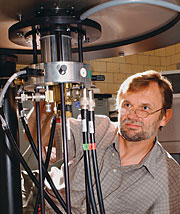- Number 293 |
- August 17, 2009
Probing materials’ structure with solid-state NMR

Marek Pruski
When it comes to explaining characteristics of particular materials, Ames Laboratory senior physicist Marek Pruski can, quite literally, put his own unique spin on the subject. Pruski is part of an unusual concentration of solid-state nuclear magnetic resonance (NMR) spectroscopy specialists located at the DOE Office of Science’s national laboratory in the center of Iowa.
Just as physicians use magnetic resonance imaging to give them a more complete internal picture of a patient than revealed by an X-ray, Pruski uses a similar technology to reveal the complex relationship between the nuclei of molecules in a material. When samples are placed in a high magnetic field, different quantum mechanical states of the nuclei in the material are associated with different energies. Measuring the transition frequency between these states provides a snapshot of the molecular structure.
“Even though the technology has been around for roughly 65 years, it’s still evolving and changing, even on a monthly basis,” Pruski says. “It’s fascinating and the constant push to expand the capabilities keeps me excited about the work.”
Much of the push has been to improve both the resolution and sensitivity of the technology. One area Pruski and his coworkers have been pursuing is associated with utilization of fast magic angle spinning. By physically spinning the sample at high speed, up to 3 million rpm, it in effect neutralizes some of the interactions that broaden the spectra in solids. Another area of his recent interest was the development of techniques for studying half-integer quadrupolar nuclei.
Though solid-state NMR sounds as if it would be a fairly specialized field, Pruski says that it is actually quite broad and that there’s little overlap among the collection of NMR researchers at Ames Laboratory. Pruski’s group is currently focused on the studies of heterogeneous catalysts, mesoporous silica nanoparticles and metal hydrides.h
Submitted by DOE's Ames Laboratory
